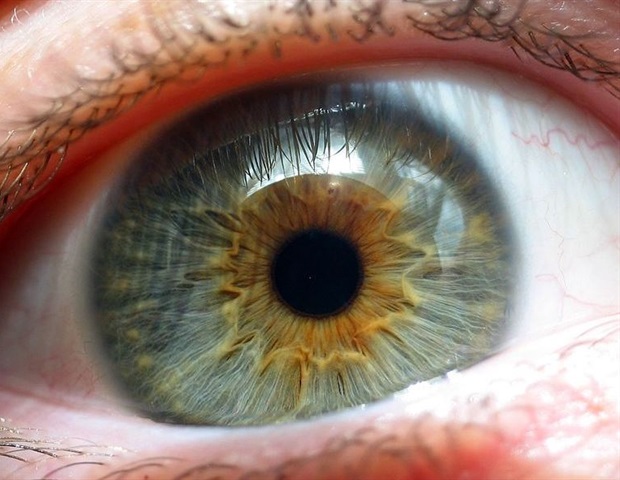
A brand new examine from researchers at Wilmer Eye Institute, Johns Hopkins Medication explains not solely why some sufferers with moist age-related macular degeneration (or “moist” AMD) fail to have imaginative and prescient enchancment with therapy, but in addition how an experimental drug might be used with present moist AMD remedies to avoid wasting imaginative and prescient.
Moist AMD, considered one of two sorts of AMD, is a progressive eye situation attributable to an overgrowth of blood vessels within the retina, the light-sensing tissue within the eye that additionally relays imaginative and prescient indicators to the mind. Such blood vessels -; attributable to an overexpression of a protein often called VEGF that results in blood vessel progress -;then leak fluid or bleed and injury the retina, inflicting imaginative and prescient loss.
Regardless of the extreme imaginative and prescient loss usually skilled by individuals with moist AMD, lower than half of sufferers handled with month-to-month eye injections, often called anti-VEGF therapies, present any main imaginative and prescient enhancements. Moreover, for many who do profit with improved imaginative and prescient, most will lose these good points over time.
Now, within the full report revealed the week of November 4 within the Proceedings of the Nationwide Academy of Sciences, the Wilmer-led group of researchers share how such anti-VEGF therapies may very well contribute to lack of imaginative and prescient enhancements by triggering the overexpression of a second protein. Referred to as ANGPTL4, the protein is just like VEGF, as it will possibly additionally stimulate overproduction of irregular blood vessels within the retina.
Now we have beforehand reported that ANGPTL4 was elevated in sufferers who didn’t reply nicely to anti-VEGF therapy. What we noticed on this paper was a paradoxical improve of ANGPTL4 in sufferers that obtained anti-VEGF injections – the anti-VEGF remedy itself turned on expression of this protein.”
Akrit Sodhi, M.D., Ph.D., corresponding writer and affiliate professor of ophthalmology and the Branna and Irving Sisenwein Professor of Ophthalmology on the Johns Hopkins College Faculty of Medication and the Wilmer Eye Institute
The group in contrast VEGF and ANGPTL4 ranges within the eye fluid of 52 sufferers with moist AMD at varied phases of anti-VEGF therapy. Previous to anti-VEGF injections, sufferers with moist AMD had excessive ranges of ANGPTL4 and VEGF proteins. After therapy, their VEGF ranges predictably decreased, but ANGPTL4 ranges rose larger, indicating ANGPTL4 remained energetic following the anti-VEGF injections and the remedies contributed to a rise in ANGPTL4. Such ANGPTL4 exercise can result in blood vessel overgrowth and lack of imaginative and prescient enchancment.
The group then investigated methods to bridge the hole between sufferers with elevated ANGPTL4 following anti-VEGF remedies by testing the experimental drug 32-134D in mice with moist AMD. The drug decreases ranges of a 3rd protein, HIF-1, identified to be concerned in moist AMD and diabetic eye illness for its position in switching on VEGF manufacturing. Researchers believed the HIF-inhibitor 32-134D would have an identical impact on ANGPTL4 following anti-VEGF therapy, since ANGPTL4 manufacturing can also be turned on by HIF-1.
In mice handled with 32-134D, the group noticed a lower in HIF-1 ranges and VEGF, in addition to decreased ranges of ANGPTL4 and blood vessel overgrowth. Mice handled solely with anti-VEGF therapies corroborated the group’s findings in human sufferers: ranges of VEGF had been decrease, but ANGPTL4 ranges rose, stopping anti-VEGF therapies from totally working to stop blood vessel progress (and imaginative and prescient loss). Researchers additionally decided that combining 32-134D with anti-VEGF remedies prevented the rise in HIF-1, VEGF and ANGPTL4. This therapy mixture was simpler than both drug alone, displaying promise for treating moist AMD.
“This work exposes a approach to enhance anti-VEGF remedy for all sufferers and doubtlessly assist a subset of sufferers with moist AMD who nonetheless lose imaginative and prescient over time regardless of therapy,” Sodhi says. “Our hope is that this [project] will additional the three objectives we now have associated to moist AMD: make present therapies as efficient as attainable, establish new therapies, and stop individuals from ever getting moist AMD.”
The examine’s different authors embrace Deepti Sharma, Evan Lau, Yu Qin, Murilo Rodrigues, Chuanyu Guo, Emma McIntyre, Shaima Salman, Yousang Hwang, and Gregg L. Semenza of Johns Hopkins College Faculty of Medication; Aumreetam Dinabandhu and Silvia Montaner of the College of Maryland; and Ala Moshiri on the College of California Davis. Aumreetam Dinabandhu and Yu Qin even have affiliations with the Johns Hopkins College Faculty of Medication and the Eye Hospital of China Medical College, respectively.
This work was supported by the Nationwide Institutes of Well being grants R01EY029750, R01EY032104, EY001765 (the Wilmer Core Grant for Imaginative and prescient Analysis, Microscopy and Imaging Core Module); the TEDCO Maryland Innovation Initiative; the Analysis to Forestall Blindness, Inc., Particular Scholar Award, the Sybil B. Harrington Stein Innovation Award, and an unrestricted grant to the Wilmer Eye Institute, Johns Hopkins Faculty of Medication; the Armstrong Household Basis; the C. Michael Armstrong Professorship and analysis funding from the Armstrong Household Basis; and the Branna and Irving Sisenwein Professorship in Ophthalmology. The funding organizations had no position within the design or conduct of this analysis. Akrit Sodhi and Gregg L. Semenza are co-founders of and maintain fairness in HIF Therapeutics, Inc. Shaima Salman, Yousang Hwang, Akrit Sodhi and Gregg L. Semenza are inventors on provisional patent software PCT/US2022/039883.

